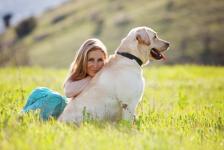Do Women Make Dogs Territorial?
Is the adopted dog barking more and more because his guardian is female?
Jolanta Benal, CPDT-KA, CBCC-KA
Listen
Do Women Make Dogs Territorial?
 A reader, I’ll call her Jenny, wrote to say she adopted a Dachshund-Min Pin mix a few months ago. Jenny described Hank as “cautious” with other people and told me he barks more and more during their walks. Yet if they go someplace crowded, such as a street fair, he seems happy. The shelter staff told Jenny that because she’s a woman, Hank might become protective or territorial toward her. Jenny wondered: Was protectiveness behind Hank’s barking, or was it something else? This week, a few words about us ladies and our dogs, and some thoughts what might make an unhappy dog seem happy.
A reader, I’ll call her Jenny, wrote to say she adopted a Dachshund-Min Pin mix a few months ago. Jenny described Hank as “cautious” with other people and told me he barks more and more during their walks. Yet if they go someplace crowded, such as a street fair, he seems happy. The shelter staff told Jenny that because she’s a woman, Hank might become protective or territorial toward her. Jenny wondered: Was protectiveness behind Hank’s barking, or was it something else? This week, a few words about us ladies and our dogs, and some thoughts what might make an unhappy dog seem happy.
Also, The Dog Trainer is holding a contest. On Wednesday, October 13, and Thursday, October 14, post your photos and stories of you and your dog playing on my Facebook page. The following weekend, I’ll pick a lucky winner to get a signed copy of Play with Your Dog, a delightful and comprehensive guide by Pat Miller. Facebook fans who are actual personal friends of mine aren’t eligible to win, but I’d love to see your photos anyway!
Are Male Dogs Protective of Women?
All right, let’s get the woman thing out of the way. Is a male dog especially likely to be territorial or protective of a woman? Do canine boys get all chivalrous about human girls?
Um, no. My clients of all genders have the same kinds of problems with their dogs, though they might perceive them or describe behavior in different ways.
Outdated training guides could be the culprits here; I have dim memories of folklore about dogs being more obedient toward men or more likely to try to dominate women. Possibly this grew out of the amount of force trainers relied on in the bad old days. Not that men are naturally meaner to dogs than women are, but if the only way you know how to train a dog is to yank him around with the choke chain, it’s handy to have some testosterone-enhanced muscle on board.
The underlying dominance-and-mastery, must-be-alpha mindset still takes up precious storage space in a lot of brains; an unruly dog must be dominating his female owner. (1) Or claiming her as his territory. Or trying to protect her. Or something. Since nothing we actually know about dogs supports the idea that Hank barks on account of his deep manly urges, let’s go with “something.”
A Dog’s Breed or Mix Can Contribute to His Barkiness
Nothing we know about dogs suggests that they bark because of their chivalrous, manly urges.
We have a clue or two about what that something might be. One, Hank is mixed Dachsie and Min Pin. Neither breed is known for a tranquil approach to life. I’m generalizing, of course–all dogs are individuals, and somewhere out there is a Zen Master Dachsie-Min Pin mix. Odds are, though, that Hank’s genetic heritage contributes to his barkiness.
An Undersocialized Dog May Learn to Bark at People
Two, Jenny says Hank is cautious with other people, and that his barkiness is increasing. We don’t know anything about Hank’s early life, so I can only speculate on the basis of my experience. When I meet a cautious or shy dog whose early history is known, I nearly always find he didn’t get out much in his young puppyhood. He wasn’t given the varied, pleasant early experiences of many people and situations that would leave him feeling comfortable with everything a modern dog encounters in daily life.
Often, as these undersocialized puppies grow up, they stop retreating from the things that worry them and start to bark or even lunge at them instead. At a year and a half old, Hank is nearing social maturity. And remember, his breed mix inclines him to be vocal anyway.
Aha! you say. But what about the fact that Hank is “happy” in crowded situations like farmer’s markets and street fairs?
A Dog May Seem “Happy” but Actually Feel Anxious
Jenny may be misreading Hank’s body language. Maybe he’s just plain overwhelmed by big crowds and lots of noise, and so he stops reacting. I’ll go out on a limb and say that’s probably the case. The picture would be that Hank’s not barking; maybe he’s either walking quietly next to Jenny or else pulling in all directions, a behavior that can reflect either great eagerness or great anxiety. Hank could be pretty darn anxious and still look good to the average person’s eye. And not just the average person’s, either, so Jenny shouldn’t feel bad. At least one celebrity trainer routinely makes the same mistake.
Hank could use some good in-person professional help. Assuming I’ve got his number, here’s a sketch of what I’d do if I were working with Jenny in person. Bear in mind that because I don’t actually know Hank and because this is just a short article, what follows is greatly simplified.
Reward-Based Training Can Help a Dog Feel Better
I’d set up a reward-based training program with skills tailored to Hank so that Jenny could better direct his behavior in tricky situations. The rewards would make training fun for Hank. Fun is relaxing for dogs as well as for people, and the good feelings from reward-based training would carry over and help Hank cope with his anxiety. In addition, as I’ve said many times in these articles, consistency and predictability reduce stress. Consistent, reward-based rules are a cornerstone of modern behavior modification. (2)
Cut Out Stressors in an Anxious Dog’s Life
I would help Jenny identify the stressors in Hank’s life so we could reduce them while we improved his coping skills. Some stressors, we’d cut out entirely. We’d work to change Hank’s emotional response to the things that worried him. In the behavior modification technique called counterconditioning and desensitization, we’d present those worrisome things, such as strangers, in very mild forms. Then we’d pair them with delicious treats, play, and other goodies. For instance, we might give Hank bits of chicken whenever an unfamiliar person appeared.
Cautious, shy, and fearful dogs should never be forced into situations that frighten them, but Jenny could praise and encourage Hank for keeping his cool and checking out new things. In general, we’d gradually help Hank feel safer and more confident in the world, and as a result we’d expect him to bark less.
Remember to post your play photos and stories to The Dog Trainer’s Facebook page on October 13 and 14. If you don’t have play photos and stories, post anyway just to say hi. You can also email me at dogtrainer@quickanddirtytips.com; I may use your question as the basis for a future article. Thanks for reading, and here’s to happy dogs.
Notes
-
For an excellent discussion of the history of the dominance paradigm, see this article by the veterinary behaviorist Dr. Sophia Yin.
-
I discuss the importance of consistency in my article about small dogs, on the following link.
Woman and Dog image courtesy of Shutterstock

